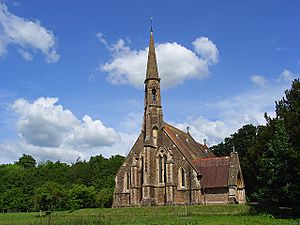St Mary's Church, South Tidworth facts for kids
Quick facts for kids St Mary's Church |
|
|---|---|
 |
|
| Location | South Tidworth, Wiltshire, England |
| Built | 1878 |
| Architect | John Johnson |
| Architectural style(s) | Gothic Revival |
|
Listed Building – Grade I
|
|
| Designated | 7 March 1973 |
| Reference no. | 1093240 |
| Lua error in Module:Location_map at line 420: attempt to index field 'wikibase' (a nil value). | |
St Mary's Church in South Tidworth, Wiltshire, England, was built in 1878. It is recorded in the National Heritage List for England as a designated Grade I listed building, and is now a redundant church in the care of the Churches Conservation Trust.
The church was built of rock faced brown stone, in a Gothic Revival style, by John Johnson, with work supervised by G.H. Gordon, for Sir John Kelk, near the site of an older medieval parish church. Kelk, an engineer and major building contractor who owned the Tedworth House estate nearby, had previously worked with Johnson on the construction of the Alexandra Palace. St Mary’s cost Kelk £12,000.
The chancel is 28 feet (8.5 m) by 17 feet (5.2 m) and the three by nave 43 feet (13 m) by 17 feet (5.2 m). There are also north and south aisles and a north vestry and a south porch. There is a bell turret with a tapering spire, also known as a flèche, at the top of a buttress on the west wall. Pevsner describes the bell tower as "perverse and wilful...à la Burges".
Pevsner considers the interior "sensational, in scale as in everything else". It includes carvings and polished marble shafts in the columns of the arcade piers. The chancel floor is laid with Italian mosaic. There is also a silver chalice and patens of 1837 and 1877 and a silver-gilt flagon of 1869. The altar and stone carvings were built by Farmer & Brindley. The stained glass is by Clayton and Bell apart from the east window which was designed by Heaton, Butler and Bayne.
Outside the church is an avenue of yew trees the largest of which has a girth of 7 feet 9 inches (2.36 m).
The church was declared redundant on 1 September 1972, and was vested in the Trust on 19 December 1973. Access to the church is restricted after vandalism in 2016.

